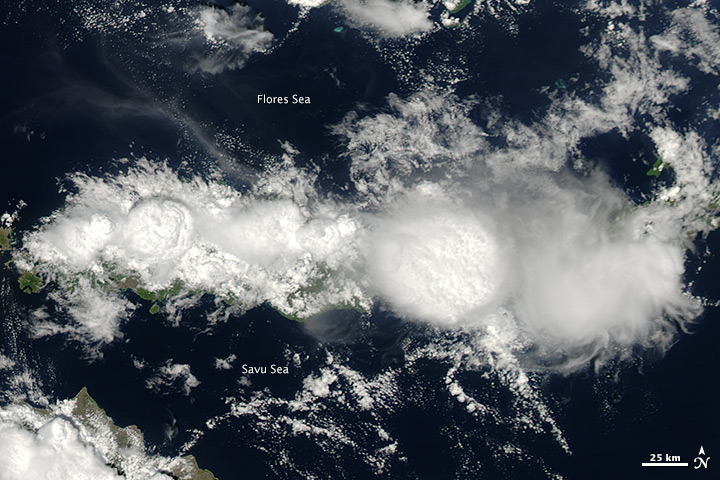In a view from high altitude, height
can be a difficult thing to gauge. The highest of clouds can appear to
sit on a flat plane, as if they were at the same elevation as the ocean
or land surface. In this image, however, texture, shape and shadows lend
definition to mushrooming thunderheads over the Indonesian island of
Flores. The Moderate Resolution Imaging Spectroradiometer (MODIS) on NASA’s Aqua satellite acquired this image on the afternoon of December 2, 2013.
The towering clouds are so well defined that it is easy to visualize
the rapidly rising air that is fueling them. “This looks like a classic
example of island convection that is enhanced by topography,” says NASA
scientist Joseph Munchak.
During the day, sunlight heats the land more quickly than it heats
the ocean. The warm air over land rises, creating an area of low
pressure that pulls in cool air from the ocean. The result is a sea breeze.
On this Indonesia island, the sea breeze from the Flores Sea on the
north blows inland and clashes with the sea breeze blowing inland from
the Savu Sea in the south. When the two breezes meet in the center of
Flores, they push the air up. The rising air cools and condenses into a
line of clouds.
Sea breeze convection is not the only force at work here. On Flores, cloud formation has help from the shape of the land.
A line of tall volcanoes runs down the spine of the island, and their
steep slopes also force air to rise. So, moist ocean air blows inland,
hits the mountains and volcanoes and rises with the slope. Above the
mountains, the rising air meets the rising sea breeze from the other
side, and the upward motion is reinforced.
The combination of the two forces pushes air high into the
atmosphere, resulting in large towering clouds of the sort that usually
produce thunderstorms. In fact, a weather station on Flores
reported rain and thunderstorms on December 2. This type of convection
is strongest in the early afternoon, says Munchak, just about the time
when Aqua MODIS acquired the image. The clouds were just beginning to
form when Terra MODIS passed over earlier in the day.
References
- NOAA National Weather Service (2010, July 13) The sea breeze. Accessed December 6, 2013.
- Weather Underground (2013, December 2) Weather history for Ruteng/Satartacik, Indonesia. Accessed December 6, 2013.
NASA image courtesy Jeff Schmaltz, LANCE/EOSDIS MODIS Rapid Response Team at NASA GSFC. Caption by Holli Riebeek.
- Instrument:
- Aqua - MODIS
NASA: Cloud Towers - 12.22.13
You have an alphabetical guide in the foot of the page in the blog: solitary dog sculptor
In the blog: Solitary Dog Sculptor I, the alphabetical guide is on the right side of the page
Thanks
Usted tiene una guía alfabética al pie de la página en el blog: solitary dog sculptor
En el blog: Solitary Dog Sculptor I, la guia alfabética está en el costado derecho de la página
Gracias
Ricardo M Marcenaro - Facebook
Blogs in operation of The Solitary Dog:
solitary dog sculptor:
http://byricardomarcenaro.blogspot.com
Solitary Dog Sculptor I:
http://byricardomarcenaroi.blogspot.com
Para:
comunicarse conmigo,
enviar materiales para publicar,
propuestas comerciales:
marcenaroescultor@gmail.com
For:
contact me,
submit materials for publication,
commercial proposals:
marcenaroescultor@gmail.com
My blogs are an open house to all cultures, religions and countries. Be a follower if you like it, with this action you are building a new culture of tolerance, open mind and heart for peace, love and human respect.
Thanks :)
Mis blogs son una casa abierta a todas las culturas, religiones y países. Se un seguidor si quieres, con esta acción usted está construyendo una nueva cultura de la tolerancia, la mente y el corazón abiertos para la paz, el amor y el respeto humano.
Gracias :)


No hay comentarios:
Publicar un comentario